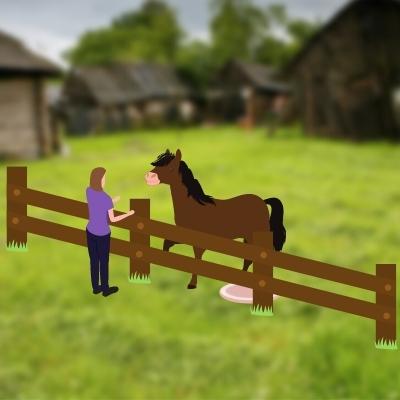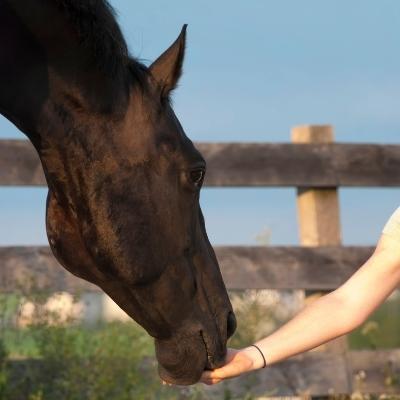With positive reinforcement training for horses becoming more mainstream, you might have heard the term “protected contact” before. So what is protected contact for horses? In this post, we’ll cover the basics of protected contact training and how this powerful training tool can help you and your horse.
What Is Protected Contact Horse Training?
Protected contact for horses is training a horse from the other side of a barrier. Simple, right? You’re on one side of a fence, half wall, or corral panel and your horse is on the other.

It’s a simple concept, but one that may not come naturally to equestrians. We’re used to working and training in the same space as horses. How could placing a barrier between you and your horse be useful for training?
Protected contact is a strategy sometimes used in positive reinforcement training. The “protected” part of protected contact training means that you and your horse are each protected from fully accessing one another. Your horse can’t make unwanted contact with you, and vice versa.
You’ll usually be able to reach through with your hands to touch your horse or provide a reward, depending on the content of your training session. Your horse will be unrestrained and free to stay or leave.
Note that you’ll sometimes see this concept mislabled protective contact for horses. This wording isn’t quite correct, but it sounds similar and gets the same point across.
When Can You Use Protected Contact?
Almost all traditional horse training – whether classical, “natural,” or any other type of training – involves horse and human sharing the same space. After all, there’s no barrier between the two of you while tacking up or riding, so most other training or groundwork also involves being in the same aisle, pen, or arena as the horse. This makes it easy to directly control a horse’s actions through pressure or physical aids.
Protected contact changes the equation. Your horse can’t get in your space or hurt you (accidentally or on purpose), but it also means that you don’t control your horse’s location or actions. They’re not under restraint and you’re not able to follow them if they choose to leave.
For this reason, you’ll use protected contact in some positive reinforcement training sessions, where horses happily offer behaviors and you give them a reward for their efforts.
In positive reinforcement training, such as clicker training, you don’t use restraint or force to keep your horse around for the session. They do it because the learning is fun and they’re able to earn rewards. So keeping a barrier between the two of you is no problem, and actually has several benefits.
The Benefits of Protected Contact for Horses
The main reason to use protected contact in horse training is because it greatly increases human safety. In free contact, a horse who is afraid, careless, or angry can act out by kicking, biting, rearing, or other unsafe behavior. This makes good material for a viral TikTok but doesn’t do much to keep you in one piece or your horse sane.
Protected contact makes accidents almost impossible, because all you have to do to stay safe is to stay on the other side of the fence.
The technique is actually borrowed from the zoological field. Modern zoos only train or handle large animals such as elephants and tigers in protected contact. It’s just safer for everyone involved, and prevents accidents.

I can hear the reply now: horses aren’t tigers. They’re domesticated animals. When they act rank or dangerous, the best response is a fast and clear correction to punish the bad behavior. Right?
Not always. When a horse acts unsafe or refuses behavior in traditional, free contact, our first course of action is usually to discipline the horse. But we know that physical punishment usually isn’t the best long-term solution. It often doesn’t solve the behavior and can lead to escalating aggression from your horse, plus a seriously damaged relationship.
Protected Contact for Aggressive Horses
When you train an aggressive or reactive horse in protected contact, you turn the tables on their aggressive behavior. It’s no longer possible for them to hurt a person, so you’re no longer forced into the position of using physical correction to stay safe.
This can be a breath of fresh air for your troubled horse, no matter what’s causing their aggression. It’s crucial to realize that bad behaviors are often caused by pain, fear, or the memory of either. It’s not because your horse is just a jerk or trying to get away with something.
By training with a barrier between you and your horse, you stay safe while your horse unlearns problem behavior. And if the aggressive behavior was a result of pain or fear, the fact that protected contact goes hand in hand with force-free training means that there’s less chance of triggering the aggression in the first place.
Protected Contact for Fearful Horses

Some horses have troubled behavior resulting from fear or anxiety around people. They may also be too afraid of humans to be caught or handled. If this is your horse, protected contact can be a game changer.
As with aggressive horses, protected contact training is based in positive reinforcement. It’s cooperative, meaning that your horse learns at their own pace.
This might seem like a drawback at first, but a horse who isn’t scared learns faster and more effectively than a nervous one. Positive reinforcement is ideal for unhandled equines or horses with history of phobias, trauma or abuse.
Protected contact takes it a step further by keeping the humans out of the horse’s space. For fearful equines who haven’t learned to trust humans, this creates a powerful feeling of safety and security. By using protected contact alongside clicker training or other reward-based methods, you can teach your scared horse valuable skills while building their trust and confidence. It’s fear-free learning at its best.
Eager, Excited Horses
A third situation where protected contact shines is when teaching a horse how to behave correctly around people.
Many people think that treats will make their horse pushy or aggressive. But this isn’t really true – how horses behave during positive reinforcement sessions has a lot more to do with how well we use those treats and communicate with the horse.
If your horse is new to positive reinforcement and hasn’t learned good manners yet, protected contact can start you off on the right hoof. It’s also great for horses who struggle with food anxiety. The barrier keeps your horse from making a mistake and getting into your personal space. It gives you the chance to teach them better manners without bringing physical punishment into the picture.
What Can You Teach Horses in Protected Contact?
Protected contact isn’t just for scared, aggressive, or eager horses. You can use it with any horse. Protected contact is empowering for both of you! Your horse will appreciate the control they have over the training session, and you’ll know that your horse is working with you because they’re truly motivated.

You can teach your horse any of these behaviors or good manners by using protected contact:
- Targeting (following or touching a target stick or object)
- Self-haltering and bridling
- Happily accepting fly spray
- Hoof care, including picking up feet on their own
- Ear and eye handling
- Cooperative deworming
- Voluntary injections, temperature checks, and other veterinary care
- Blanketing
And lots more!
Are There Any Drawbacks to Protected Contact with Horses?
With a barrier between you and your horse, you can’t use force or pressure to produce behavior. Everything has to be fully voluntary, because you aren’t in the same space as the horse to correct or insist on behaviors.
This might seem like a drawback, but the benefits are worth any inconvenience. Remember, positive reinforcement is a different framework for training your horse. You’ll be asking for behaviors and leaving the job of saying “yes” to your horse – which can sound intimidating, but is truly empowering for both of you.
You’ll still need to know the basics of shaping behavior and rewarding your horse’s good efforts.
How to Get Started
To train in protected contact, you don’t need anything special. You’ll want to have your usual R+ or clicker training supplies, such as a target stick, treat pouch, and clicker. Of course, a good horse training planner helps too – that’s a shameless plug, but definitely check out the Positive Reinforcement Planner and the Rescue Horse Training Planner to give you an edge in your training!
The only piece of extra equipment is a sturdy non-electric barrier between your horse and you. A wooden fence works great, so one of the best ways to get started is to conduct the session on the other side of your horse’s paddock fence. If you have hotwire fencing, you’ll need to take your horse somewhere else or set up a few fence panels in the pasture for a basic session.
Add a shallow pan on your horse’s side of the barrier so that you can drop rewards into the pan. Fearful or aggressive horses often prefer this to eating from a person’s hand.
Then begin the training session! Use good principles of positive reinforcement, like breaking goals into small, simple pieces and rewarding often. Get creative and make good use of your clicker or whistle to mark the exact behaviors you want to encourage, like the moment your horse lifts their foot on their own or brings their ear close to your hand for a touch.
Then stick with it! With practice, your horse will get more and more comfortable working in protected contact and you’ll be able to take the most advantage of this powerful, force free training strategy.
Thank you for writing this article. I love to work (train) horses with protected contact for the reasons you mentioned. It’s also a great way to test your shaping skills as a trainer.
Once a behaviour is successfully trained with protective contact, one must be aware of the context shift for the horse, once you fade out the barrier. Be aware that he *could* fall back on previous learned behaviours (like mugging for a treat). Maybe a topic for next time?
I use protective contact a lot, not only with fearful horses but with all animals. (However a fence doesn’t protect very well when llama’s start spitting each other…. )
Thank you for the kind feedback! I love your work with horses and other animals. If you have other article suggestions I am ALL ears; enrichment is wonderful but filling out the training resources on the page is a goal in the works! 🙂
Those reading comments can find Sandra Poppema’s excellent services and resources for positive reinforcement based horse training at:
https://clickertraining.ca/